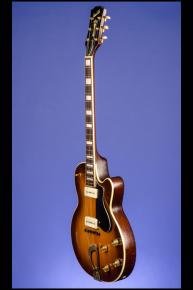In a Class By Itself - An Exceptionally Fine 1956 Guild Aristocrat M-75.
1956 Guild Aristocrat M-75.
One of a very few Carved Spruce-Top hollow body semi-solid sunburst M-75 Aristocrats shipped in 1956. This 13 1/2-inch-wide featherweight guitar weighs just 5.40 lbs. and has a nice nut width of just over 1 5/8 inches and a scale length of 24 3/4 inches. Honduras mahogany body and sides, body with single binding on the top edge, carved spruce top, three-piece mahogany/maple/mahogany neck, and bound rosewood fretboard with 22 original medium-thin frets and inlaid pearl block position markers. Headstock with Inlaid pearl "Guild" logo, pearl "Chesterfield" inlay and four layer black over white plastic truss rod cover with two screws. Serial number "4335" stamped in blind on back of headstock. Individual single-line Kluson Deluxe tuners with oval Keystone buttons. Two white plastic single-coil P-90 style pickups with outputs of 7.27k and 7.43k. Original black "Lucite" four layer black/white/black/white rounded pickguard. Four controls (two volume, two tone) plus three-way selector switch on bass bout. Transparent plastic 'gold-painted' barrel knobs with grub screws. Rosewood with pre-set compensating saddle with two separate feet. Guild 'Harp' tailpiece. The binding on the top bass side was coming away from the body (due to shrinkage) so we have had this expertly and almost invisibly repaired by master luthier Scott Lentz. The absolute minimum of belt buckle scarring on the back and a few very small marks on the top are all that prevent this wonderful and totally original example from being near mint. Housed in a modern 'TKL' black five-latch shaped hardshell case with maroon plush lining (9.25).
"Too often forgotten among the Fenders, Gibsons, Gretsches and Rickenbackers of the day, Guild only got up and running in 1952 but was producing first class instruments from day one. Much like Gretsch's Duo Jet, the M-75 Aristocrat has a semi-hollowbody made from a chambered mahogany back capped with a carved solid spruce top. It was clearly launched as competition for both the Duo Jet and Gibson's Les Paul, but original examples are usually pounds lighter than either at well under 5 pounds. Also like the other "Big G" makers of the day, Guild targeted both the jazz and rock 'n' roll crowds with this model, which ultimately became best associated with electric blues and took the name Bluesbird in later reissue incarnations. The pickups look outwardly like Gibson P-90s and are similarly designed, but they tend to have a little less of the gritty midrange hump and somewhat more snap and upper-midrange crackle. Combined with the usual construction, these pickups help give the M-75 Aristocrat a voice all its own, which is to say some of the airy richness of a good archtop but with more bite and definition." (Tony Bacon. 365 Guitars, Amps and Effects you must play. p.66).
"Unlike most of the other models in the early Guild line, the Aristocrat M-75 was not a mere descendant of the earlier Epiphone line. What as first sight looks like a solid body instrument, styled after a Gibson "Les Paul" model, is really a scaled-down version of a hollow body guitar. The following is an excerpt from the '54-catalog: "the use of an exclusively developed lighter semi-solid body construction gives the Guild Aristocrat a magnificence of tone never before achieved in a guitar of this size. And for ease of handling and playing, this light weight, semi-solid midget model is in a class by itself".
It is quite obvious that Guild was going for the players who were attracted by the compact size of the Gibson Les Paul but who did not like it's weight. Also, the sound of the M-75 was not anywhere near the sound of a Gibson Les Paul. It was a hollow body instrument and it sounded like one. Because of its smaller size and the absence of the traditional f-holes, the instrument was somewhat less prone to feedback than most of the hollow body instruments available at the time. It was also the only instrument in the early range to be offered with the shorter 24 3/4" scale length." (Hans Moust, The Guild Guitar Book, p. 56).












